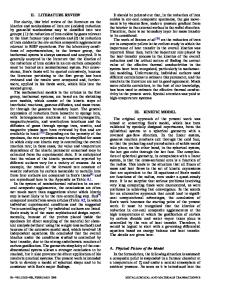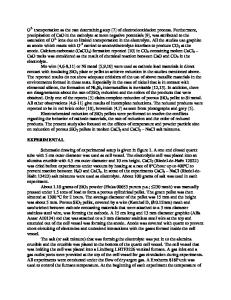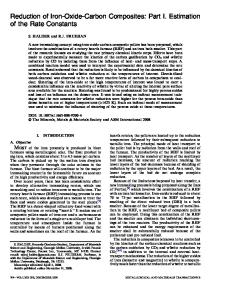Reduction of Iron-Oxide-Carbon Composites: Part III. Shrinkage of Composite Pellets during Reduction
- PDF / 686,844 Bytes
- 9 Pages / 593.972 x 792 pts Page_size
- 102 Downloads / 336 Views
INTRODUCTION
THE rotary hearth furnace (RHF) ironmaking process uses iron-oxide-carbon composite pellets to produce metallic iron. This is a coal-based process, which was developed as an alternative ironmaking process. The composites are charged in the form of spherical pellets[1,2] or a powder mixture[3] on the furnace hearth. However, when a multilayer bed of composite pellets is used, heat transfer to the lower layers of the bed limited the productivity. Thus, an alternative strategy is being proposed involving the combination of a RHF with a bath smelter.[4] The shrinkage of composite pellets has not been extensively documented in the literature, though one can find several works on the swelling of iron-oxide pellets and its association with the growth of iron in the form of whiskers. The few works that address pellet shrinkage are based on development of empirical correlations to represent the same because of the complexity of the process. Seaton et al.[5] observed that the extent of swelling of the composite pellet decreases as the temperature increases from 1223 to 1473 K with shrinkage becoming more dominant at higher temperatures. Donskoi and McElwain[6] developed a S. HALDER, formerly Graduate Student, Department of Materials Science and Engineering, Carnegie Mellon University, is with Praxair Technology Center, Praxair Inc., Tonawanda, NY 14150. Contact e-mail: [email protected] R.J. FRUEHAN, Professor, is with the Department of Materials Science and Engineering, Carnegie Mellon University, Pittsburgh, PA 15213. Manuscript submitted May 15, 2008. Article published online November 14, 2008. METALLURGICAL AND MATERIALS TRANSACTIONS B
mathematical model to study the reduction of a composite pellet and used an empirical correlation to denote the pellet shrinkage. This correlation was dependent upon two principal parameters governing shrinkage: temperature and porosity. In another work involving the modeling of reduction of a composite pellet, Fortini and Fruehan[7] used an empirical association correlating the change in local pore fraction of the pellet with the local temperature in order to capture the effects of sintering of the iron oxide.
II.
EXPERIMENTAL
In this article, experiments and mathematical modeling determined the volume shrinkage of the pellets and the external heat transport across a multilayer bed of pellets. Since the volume shrinkage occurs as a combined effect of loss of carbon and oxygen from the composite as well as sintering of iron-oxide and formation of a molten slag phase, the extent of shrinkage would exhibit a strong dependence upon the temperature and time. Furthermore, shrinkage characteristics of different materials vary from one another. The composite pellets were made out of different combinations of iron-oxide and a carbonaceous reductant of a composition similar to those used during the reduction experiments.[8] The types of pellets used were made out of artificial porous analytical hematite (PAH)-coal-char, PAH-wood-charcoal, taconite ore (TAC)-coal-char, taconite or
Data Loading...











